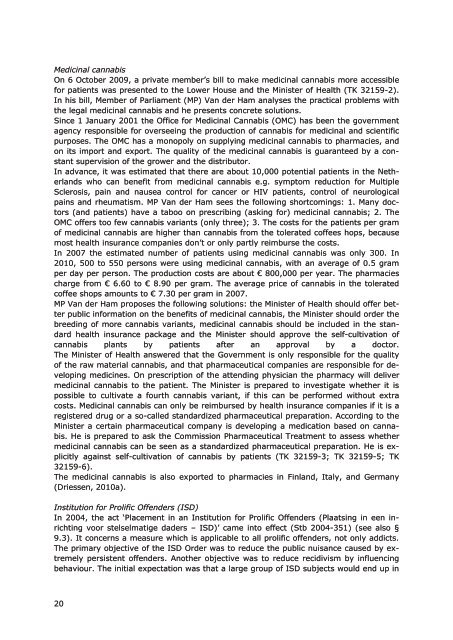The Netherlands Drug Situation 2010 - Trimbos-instituut
The Netherlands Drug Situation 2010 - Trimbos-instituut
The Netherlands Drug Situation 2010 - Trimbos-instituut
Create successful ePaper yourself
Turn your PDF publications into a flip-book with our unique Google optimized e-Paper software.
Medicinal cannabisOn 6 October 2009, a private member’s bill to make medicinal cannabis more accessiblefor patients was presented to the Lower House and the Minister of Health (TK 32159-2).In his bill, Member of Parliament (MP) Van der Ham analyses the practical problems withthe legal medicinal cannabis and he presents concrete solutions.Since 1 January 2001 the Office for Medicinal Cannabis (OMC) has been the governmentagency responsible for overseeing the production of cannabis for medicinal and scientificpurposes. <strong>The</strong> OMC has a monopoly on supplying medicinal cannabis to pharmacies, andon its import and export. <strong>The</strong> quality of the medicinal cannabis is guaranteed by a constantsupervision of the grower and the distributor.In advance, it was estimated that there are about 10,000 potential patients in the <strong>Netherlands</strong>who can benefit from medicinal cannabis e.g. symptom reduction for MultipleSclerosis, pain and nausea control for cancer or HIV patients, control of neurologicalpains and rheumatism. MP Van der Ham sees the following shortcomings: 1. Many doctors(and patients) have a taboo on prescribing (asking for) medicinal cannabis; 2. <strong>The</strong>OMC offers too few cannabis variants (only three); 3. <strong>The</strong> costs for the patients per gramof medicinal cannabis are higher than cannabis from the tolerated coffees hops, becausemost health insurance companies don’t or only partly reimburse the costs.In 2007 the estimated number of patients using medicinal cannabis was only 300. In<strong>2010</strong>, 500 to 550 persons were using medicinal cannabis, with an average of 0.5 gramper day per person. <strong>The</strong> production costs are about € 800,000 per year. <strong>The</strong> pharmaciescharge from € 6.60 to € 8.90 per gram. <strong>The</strong> average price of cannabis in the toleratedcoffee shops amounts to € 7.30 per gram in 2007.MP Van der Ham proposes the following solutions: the Minister of Health should offer betterpublic information on the benefits of medicinal cannabis, the Minister should order thebreeding of more cannabis variants, medicinal cannabis should be included in the standardhealth insurance package and the Minister should approve the self-cultivation ofcannabis plants by patients after an approval by a doctor.<strong>The</strong> Minister of Health answered that the Government is only responsible for the qualityof the raw material cannabis, and that pharmaceutical companies are responsible for developingmedicines. On prescription of the attending physician the pharmacy will delivermedicinal cannabis to the patient. <strong>The</strong> Minister is prepared to investigate whether it ispossible to cultivate a fourth cannabis variant, if this can be performed without extracosts. Medicinal cannabis can only be reimbursed by health insurance companies if it is aregistered drug or a so-called standardized pharmaceutical preparation. According to theMinister a certain pharmaceutical company is developing a medication based on cannabis.He is prepared to ask the Commission Pharmaceutical Treatment to assess whethermedicinal cannabis can be seen as a standardized pharmaceutical preparation. He is explicitlyagainst self-cultivation of cannabis by patients (TK 32159-3; TK 32159-5; TK32159-6).<strong>The</strong> medicinal cannabis is also exported to pharmacies in Finland, Italy, and Germany(Driessen, <strong>2010</strong>a).Institution for Prolific Offenders (ISD)In 2004, the act ‘Placement in an Institution for Prolific Offenders (Plaatsing in een inrichtingvoor stelselmatige daders – ISD)’ came into effect (Stb 2004-351) (see also §9.3). It concerns a measure which is applicable to all prolific offenders, not only addicts.<strong>The</strong> primary objective of the ISD Order was to reduce the public nuisance caused by extremelypersistent offenders. Another objective was to reduce recidivism by influencingbehaviour. <strong>The</strong> initial expectation was that a large group of ISD subjects would end up in20




